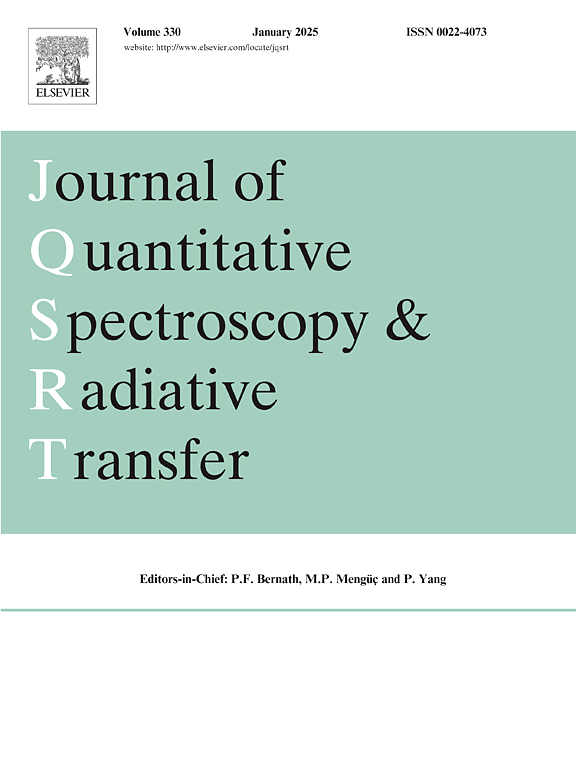Influence of hot and dense plasmas on photoionization dynamic of hydrogen-like ions
IF 2.3
3区 物理与天体物理
Q2 OPTICS
Journal of Quantitative Spectroscopy & Radiative Transfer
Pub Date : 2025-03-25
DOI:10.1016/j.jqsrt.2025.109447
引用次数: 0
Abstract
In hot and dense plasma of solar and stellar interiors, Coulomb potentials between the nucleus and electrons are screened due to the complicated many-body interactions, resulting in significant alterations in atomic structures and dynamic properties of the embedded ions as well as the macroscopic transport properties, such as opacities. Here, the photoionization dynamics of the n ≤ 2 states of hydrogen-like ions (He+, B4+, Ne9+, P14+, Ca19+, Fe25+) are investigated employing the atomic-state-dependent (ASD) screening model based on the multiconfiguration Dirac-Hartree-Fock method. It is found that the photoionization cross sections are significantly increased by the plasma screening effects, especially for the denser plasmas. For example, the photoionization cross section of 2p3/2→εd3/2 for Ne9+ increases nearly 10 times at a condition of Te =150 eV and ne=1.0 × 1025 cm-3. The present results from the ASD model show reasonable agreement with the classical Debye Hückel (DH) model in low-density plasmas, however, the DH model overestimates the densities of plasma electrons in dense plasmas due to neglecting the electron degeneracy effects. The influence of plasma screening on cross section decreases with increasing atomic number and is more significant for the excited states than the ground state. The photoionization cross sections of the ground state approximately follow the scaling law as atomic number varies, but this law can not be applied to excited states because plasma electron distribution in the ASD model depends on specific bound states. The present investigation can be applied to study the opacity under solar and stellar interior conditions.
热等离子体和致密等离子体对类氢离子光离动力学的影响
在太阳和恒星内部高温致密的等离子体中,由于复杂的多体相互作用,原子核和电子之间的库仑势被屏蔽,导致嵌入离子的原子结构和动力学性质以及不透明等宏观输运性质发生重大变化。本文采用基于多构型dirac - harree - fock方法的原子态依赖(ASD)筛选模型,研究了n≤2态类氢离子(He+、B4+、Ne9+、P14+、Ca19+、Fe25+)的光离动力学。发现等离子体屏蔽效应使光离截面显著增大,特别是对于密度较大的等离子体。例如,当Te =150 eV, ne=1.0 × 1025 cm-3时,Ne9+的2p3/2→εd3/2的光离截面增加了近10倍。在低密度等离子体中,ASD模型的结果与经典的Debye h ckel (DH)模型有一定的一致性,但由于忽略了电子简并效应,DH模型高估了致密等离子体中等离子体电子的密度。等离子体筛选对截面的影响随原子序数的增加而减小,激发态对截面的影响比基态更显著。随着原子序数的变化,基态的光离截面大致遵循标度定律,但由于ASD模型中的等离子体电子分布依赖于特定的束缚态,因此该定律不适用于激发态。本研究可用于研究太阳和恒星内部条件下的不透明度。
本文章由计算机程序翻译,如有差异,请以英文原文为准。
求助全文
约1分钟内获得全文
求助全文
来源期刊
CiteScore
5.30
自引率
21.70%
发文量
273
审稿时长
58 days
期刊介绍:
Papers with the following subject areas are suitable for publication in the Journal of Quantitative Spectroscopy and Radiative Transfer:
- Theoretical and experimental aspects of the spectra of atoms, molecules, ions, and plasmas.
- Spectral lineshape studies including models and computational algorithms.
- Atmospheric spectroscopy.
- Theoretical and experimental aspects of light scattering.
- Application of light scattering in particle characterization and remote sensing.
- Application of light scattering in biological sciences and medicine.
- Radiative transfer in absorbing, emitting, and scattering media.
- Radiative transfer in stochastic media.

 求助内容:
求助内容: 应助结果提醒方式:
应助结果提醒方式:


